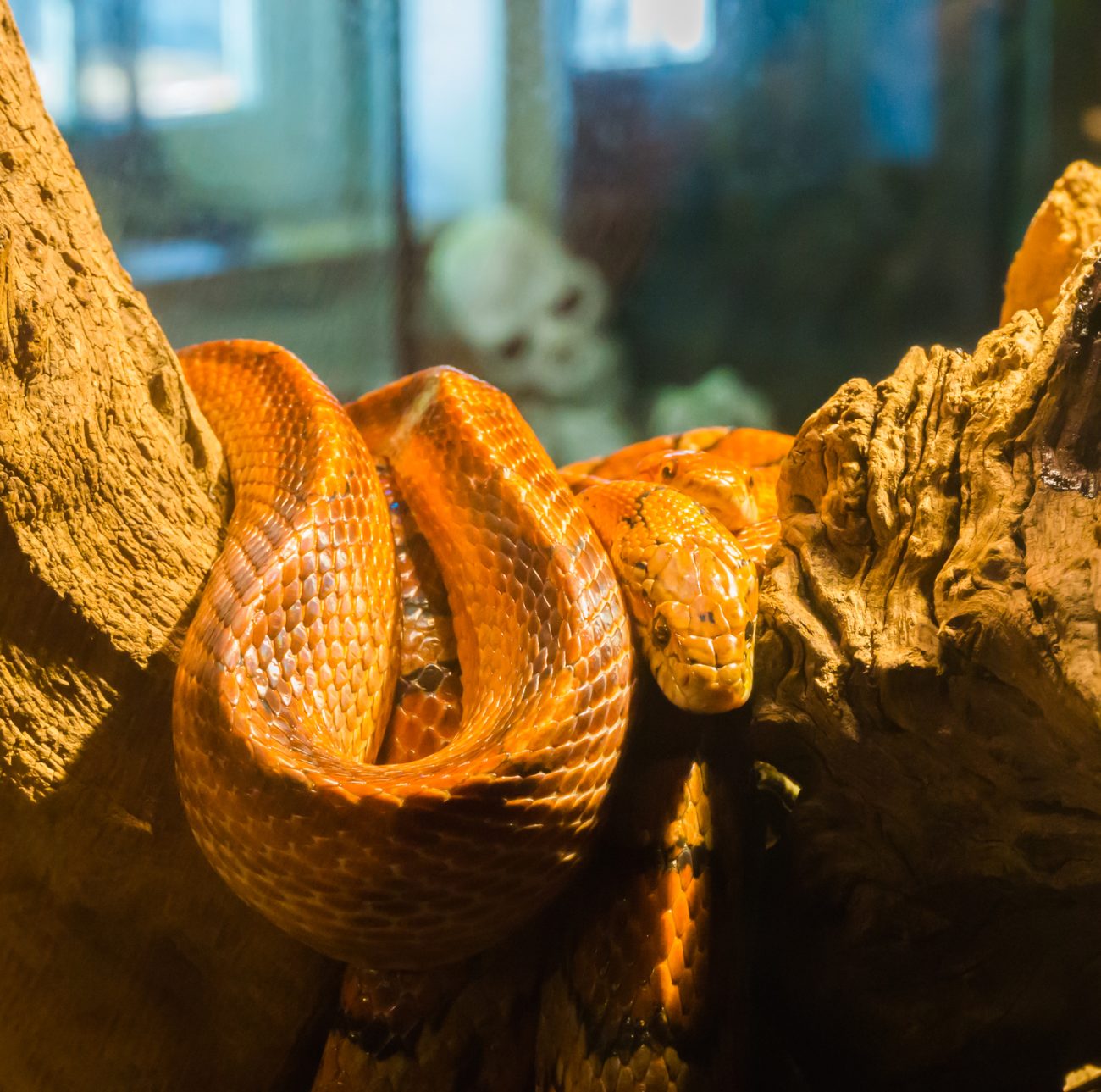Corn snakes, the red rat snake, are a common North American colubrid snake species. They typically measure between ~2-5 feet in length & can be found throughout much of the United States. They are non-venomous animals and their bites rarely hurt.
These reptiles are very popular due to their wide range of color & appearance options. While corn snakes in the wild typically have brown, black, yellow & white patterning on a grayish-orange background – morphs can have almost any combination of colors imaginable. Breeders are continuously creating new variations & color combinations.
A snake’s appearance comprises two components – pattern & color. Corn snakes have five main pattern types.
- Typical blotched pattern
- Motley (or Striped)
- Banded
- Zipper (or Zigzag)
- Plain (or Patternless)
These scaly reptiles possess interesting genetics that allows for such unique coloration and patterning.
In this article – we’ll explain what corn snake morphs are, delve into corn snake genetics and outline the most popular morphs.
What Is a Corn Snake Morph?
Corn snake morphs are the exquisite outcome of expert genetic breeding. By carefully blending corn snakes with different hues – a rainbow of beautiful mutations can be born – ranging from striking to subtle in their visual distinction & varying widely in price. These reptiles are easy to care for & make great pets for both beginner & advanced hobbyists.
While each mutation is unique, these serpents share one common trait – an alternative physical appearance to a standard corn snake, featuring distinct coloration and patterning as its defining characteristic. Mostly these patterns fall into one of five categories.
1. Typical Blotched Pattern
Corn snakes with a typical blotched pattern are arguably the most popular morphs due to their intense coloration & unique patch designs. These captivating reptiles tend to feature large, irregularly shaped blotches or saddles – that are spread across their backside – a stunning sight for any herp enthusiast! They accommodate well in tank setups that closely resemble their natural habitat.
2. Motley (or Striped)
The motley pattern is the most intricate – with blotches running along its back. Unlike other types of snakes – this one does not exhibit any markings on its belly. Depending on the individual serpent – the shape & size of these back blotches can range from thin stripes to thicker spots.
3. Banded
Banded corns are an exciting & recent development in the world of snakes. Featuring distinct crossbands that run across their ventral plates through to their backs – they appear as if adorned with cool rings all around them!
4. Zipper (or Zigzag)
The mysterious zigzag corn pattern first appeared in Florida in the 1980s. It appears to have retained its original square or rectangular blotches – but with a twist: they appear divided lengthwise and spread out – giving off an almost zipper-like effect!
5. Plain (or Patternless)
Patternless corn snakes have recently appeared and are thought to result from intensive striping effects. These unusual creatures appear with a single base color or small, random blotches scattered across their skin. They lack any distinct pattern that normally characterizes this species, hence why they’re called “patternless!”
How Corn Snake Genetics Work?
Corn snake genetics is a complex topic, that can be intimidating for beginner breeders. But understanding how corn snake genetics works is an important part of becoming a successful breeder.🙃
In the world of corn snake morphs, over 800 documented varieties have been selectively bred and refined by humans, with only five wild-type and 28 selected genetic strains serving as their true foundation. Combining these 33 genetic strains gives us the following:
- Double traits
- Triple traits
- Even staggering five-trait combinations
At the most basic level, corn snakes have two copies of each gene:
- One from their father
- One from their mother
These genes can either be dominant or recessive.
A dominant gene is expressed when it is present in only one copy – a recessive gene only shows up if both copies are present in the snake’s genome.
When two snakes are bred together, the baby snake will inherit one copy of each gene from each parent. The combination of these genes will determine what traits appear in the next generations.
To effectively breed these colorful corn snakes with desired traits – it is important to know which genes and alleles dominate or recessive, as well as what effects each gene has on physical appearance to help ensure that the desired traits are expressed in the offspring.
For Example: If one parent has a dark-banded pattern (dominant gene), but the other parent has a light pattern (recessive trait), the baby snake will likely have the dark-banded pattern as it is dominant.
Breeding two scaly serpents with different traits may also result in a heterozygous offspring; this means that the offspring inherited one copy of each allele from its parents and will express both traits.
24 Top Corn Snake Morphs
With many options, picking the best Corn Snake morph may seem overwhelming.
To help make your choice easier, I’ve compiled a list of the 29 top Corn Snake morphs – from classic hues to one-of-a-kind blends.
- Normal (Wild-Type, Classic, or Carolina)
- Alabama (Wild)
- Okeetee (Wild)
- Caramel
- Anerythristic (Anery or Anery- A)
- Charcoal (Anery-B)
- Amelanistic (Amel)
- Hypomelanistic (Hypo or Hypo-A)
- Cinder
- Diffused
- Reverse Okeetee (Albino Okeetee)
- Snow
- Lavender
- Scaleless
- Palmetto
- Tessera
- Butter
- Avalanche
- Candy Cane
- Pewter
- Ghost
- Opal
1. Normal (Wild-Type, Classic, or Carolina)
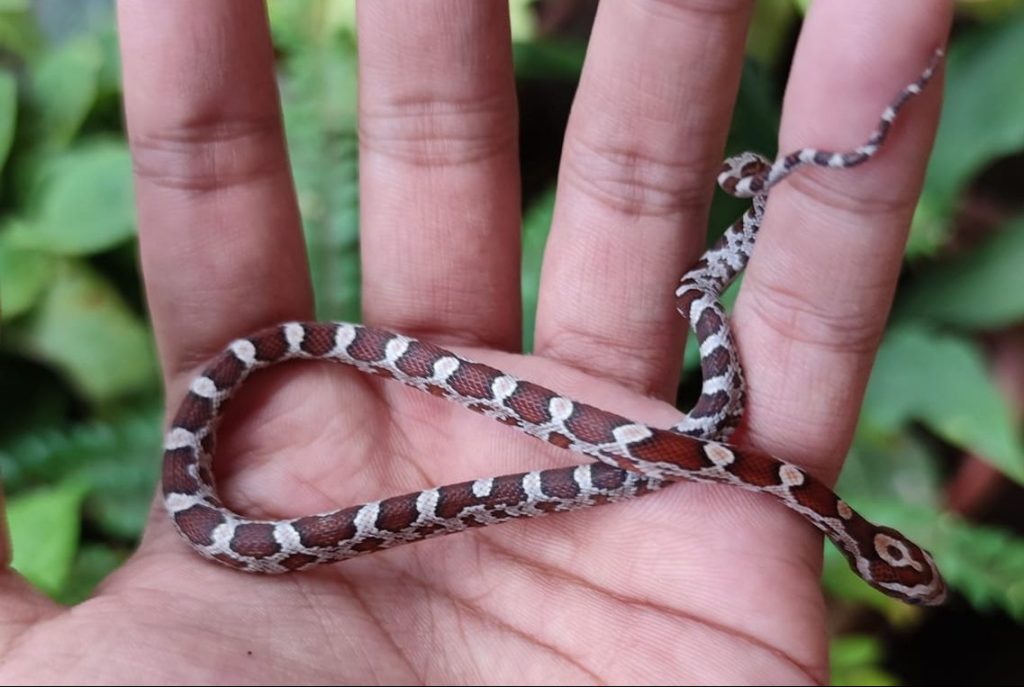
The Normal corn snake has classic features – orange skin with black lines running around its red saddle markings and a unique checkered belly of black-and-white scales. Its eyes are typically bright red or orange with a defining black pupil.
As it ages – the corn snake may develop yellow hues across its sides to deepen this already captivating look. The Normal corn snake serves as the benchmark for all other corn snakes. Being familiar with its characteristics is essential since it can help you quickly distinguish its various color mutations that can reduce, enhance or eliminate pigments. In contrast, pattern mutations might modify the shape and number of saddles or change scale size/shape.
2. Alabama (Wild)

An immensely popular species among reptile enthusiasts, these creatures make an attractive addition both in captivity as well as out in the wilderness!
3. Okeetee (Wild)
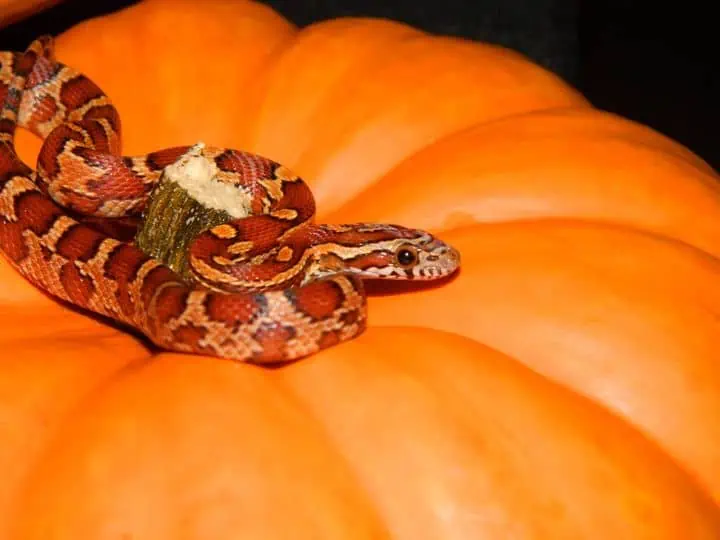
It is a wild subspecies native to South Carolina; this scaly pal has been selectively bred since its discovery.
This reptilian buddy is comparable in most aspects to Normal corn snakes, but you can distinguish between these morphs through the thickness of saddle bands, which range from ~1.25-2.5 scale thickness. Certain specimens of this crawling breed have even reached 3+ scales!😲
These captivating slithery pals boast:
- Medium brown or deep orange base colors
- Distinctive red or burnt orange dorsal blotches encircled by black margins
These alluring characteristics are guaranteed to delight any snake enthusiast’s eye!
4. Caramel
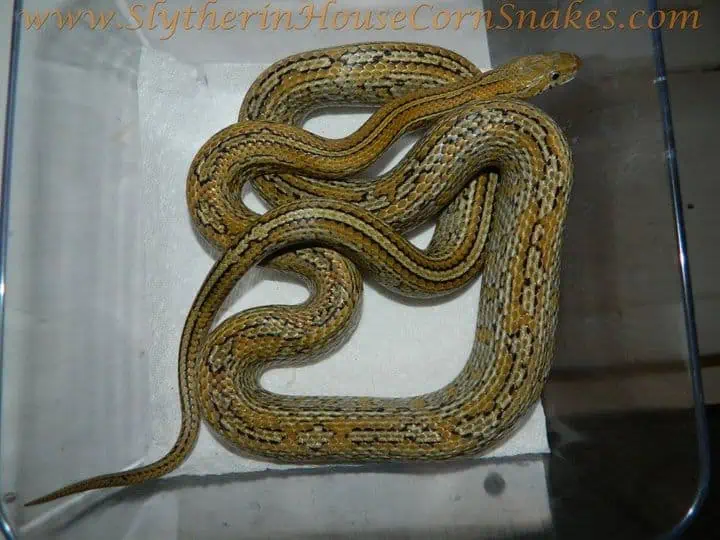
Initially, these slithery reptiles manifested this trait from wild animals captured and selectively bred for many years.
As these colorful crawling companions grow older – their pigmentation becomes more intense – with yellow overtaking much of their bodies and blotches in shades ranging from caramel to light brown or even deep chocolate appearing on them.
When newly hatched, some of these serpents may not show any yellow pigment yet!
5. Anerythristic (Anery or Anery- A)
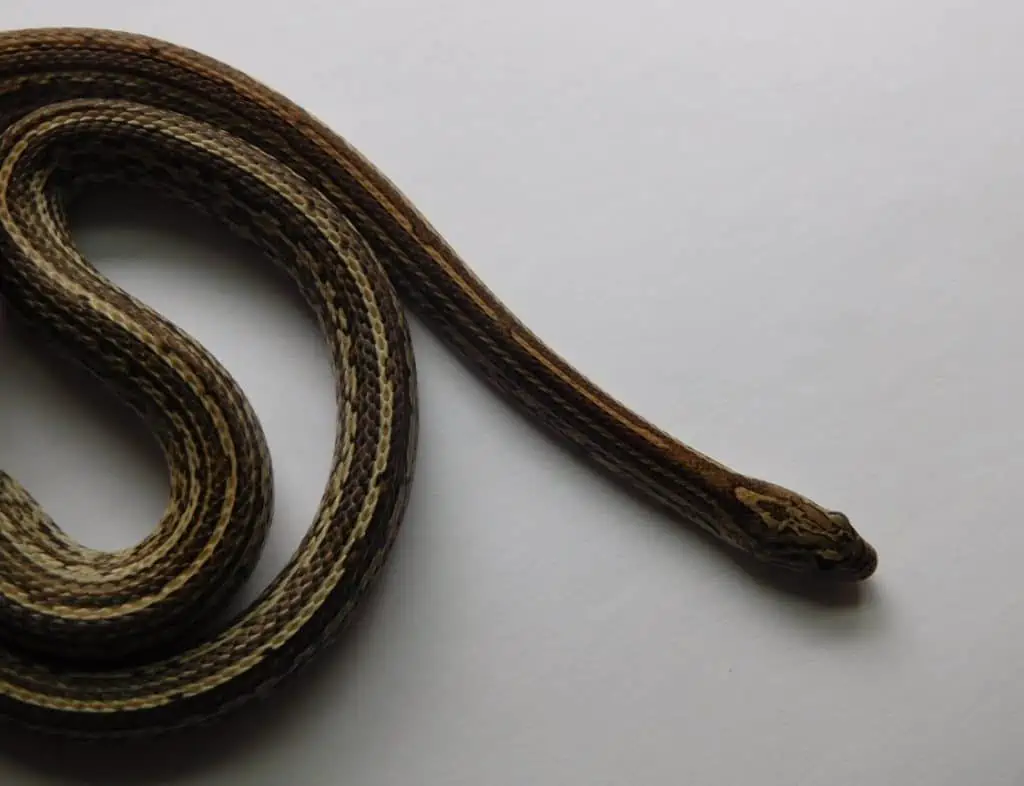
The body coloration of this sensational slithery friend consists of pale gray with dark gray blotching and black margins, with adult Anerythristics often exhibiting an additional splash of yellow around their throat area.
6. Charcoal (Anery-B)
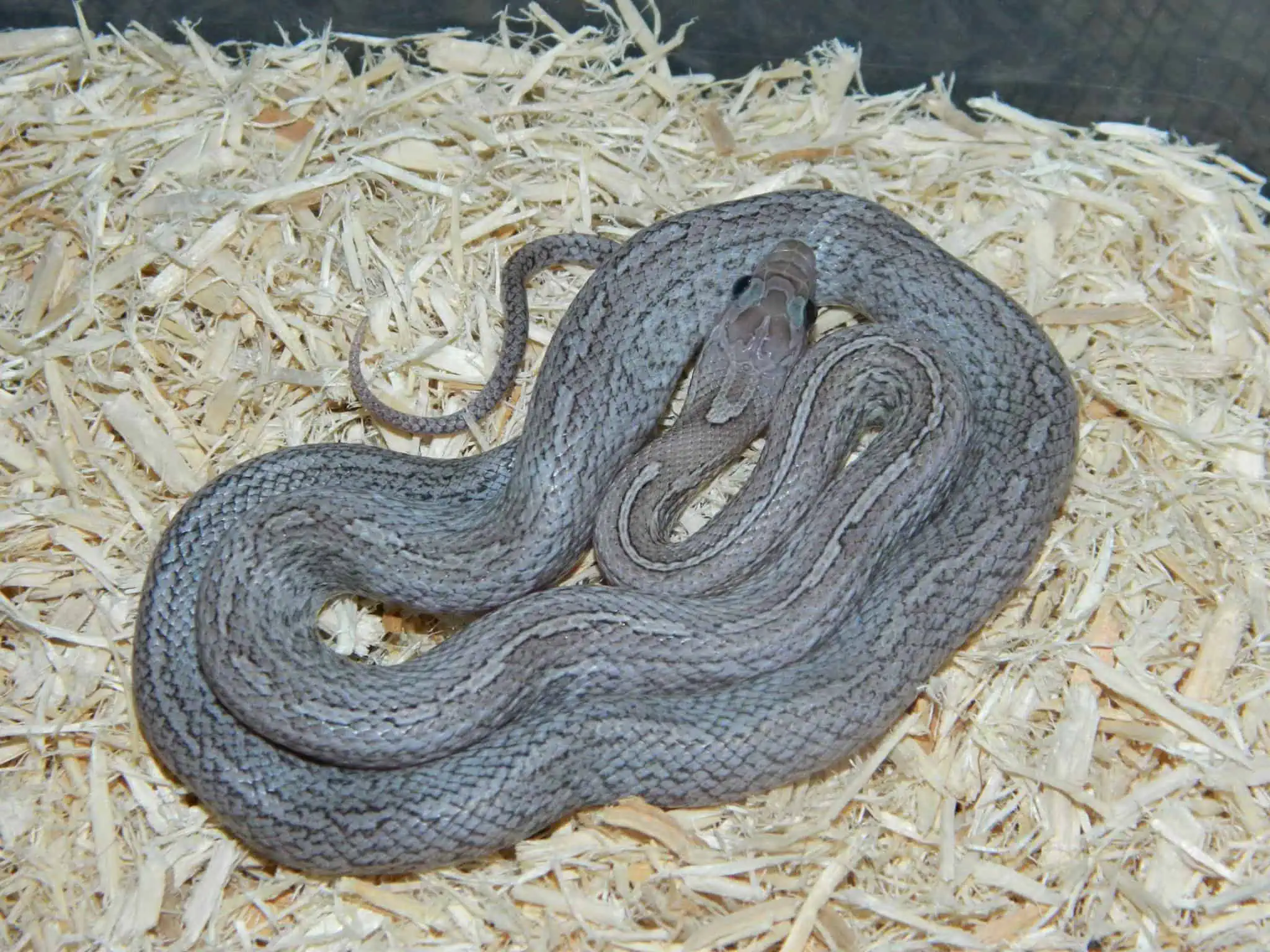
This remarkable reptilian specie is part of the same complex as type A – but does not develop yellow coloring with age – instead, this crawling buddy remains gray with dark gray blotches & black margins like all other Anery morphs that lack red, yellow, or orange pigmentation.
You can use this snake to “mute” or reduce coloration on different morphs.
7. Amelanistic (Amel)
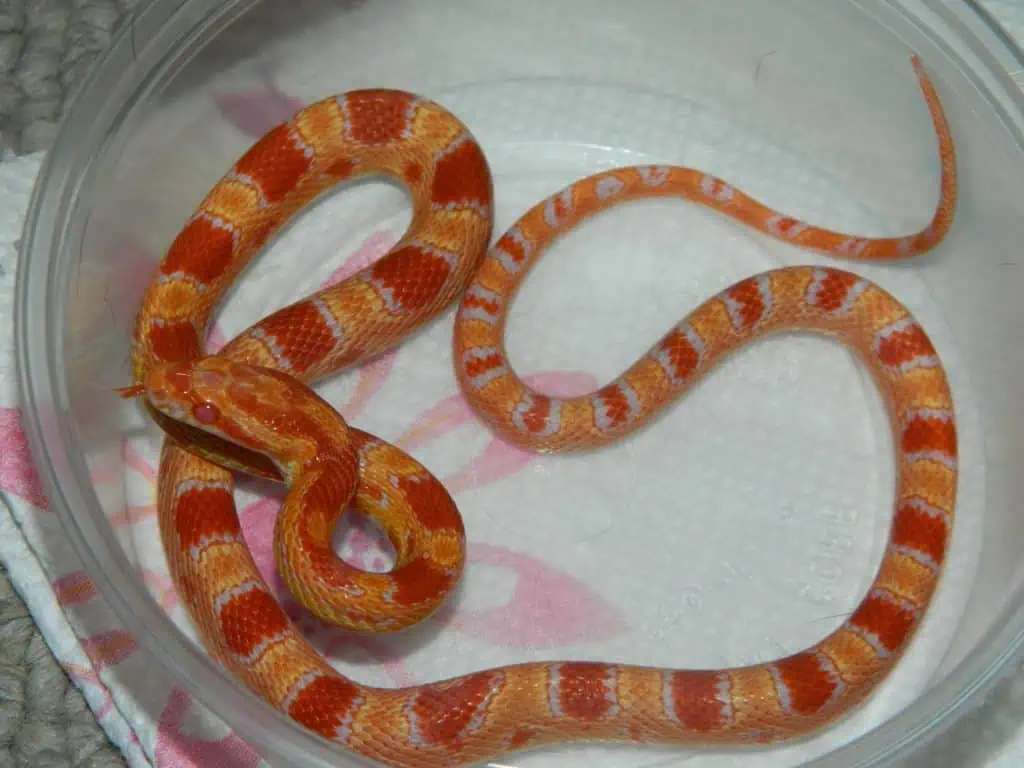
You’ll be stunned to see their exquisite eyes – often either reddish in hue or tangerine-colored – boast a striking scarlet pupil that’s particularly difficult to detect without the proper illumination!
Additionally, the bellies of these beautiful reptiles tend to be snowy white featuring clear checkers stamped with vibrant yellows and oranges.
The standard albino is derived from the Amelanistic morph gene.
8. Hypomelanistic (Hypo or Hypo-A)
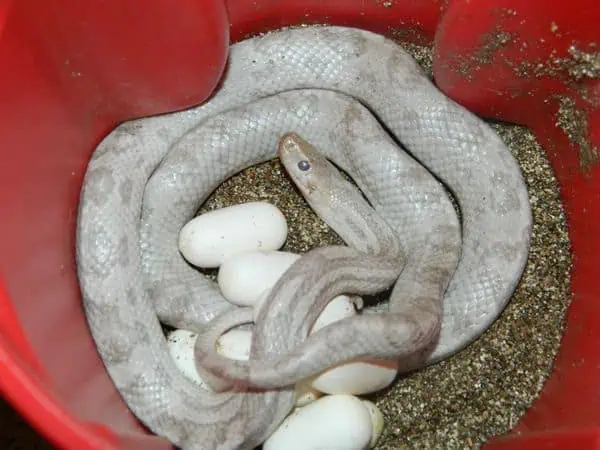
In addition to its lack of darkness, this specific type of scaly reptile is also recognized for its vibrant display of light hues, which include
- Red
- White
- Orange
- Yellow
- Gray
- Brown
9. Cinder
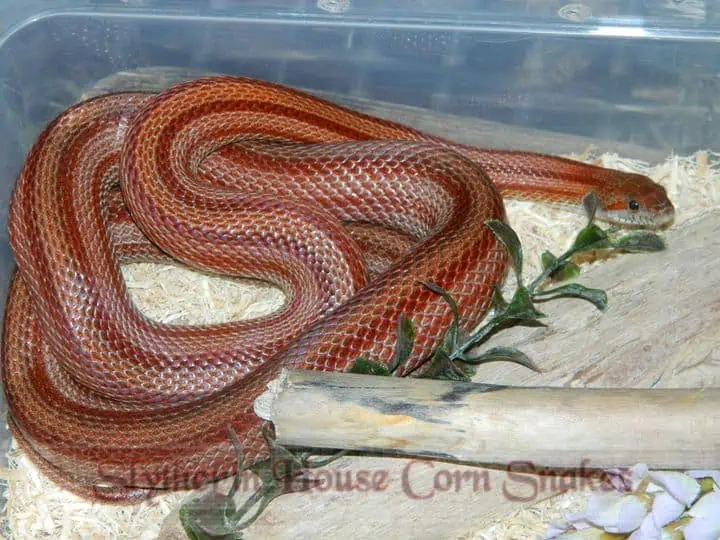
- Shades
- Patterns
The amazing features which can force you to buy this morph include the following:
- This scaly friend has an eye-catching “dovetail” design that you can view above its head – it is comprised of alternating meshing triangles.
- Cinder eliminates yellow, orange, and red pigments, leaving a remarkable brick-red pattern on top of its grayish hue.
10. Diffused
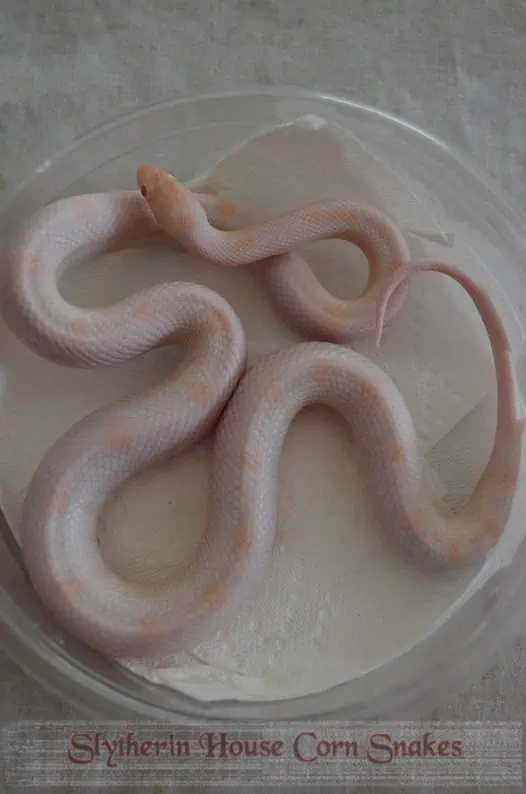
You can utilize these amazing pals to breed with other color morphs to achieve your desired result — as these slithery companions retain much of the parent’s hue but have a drastically reduced patterning.
11. Reverse Okeetee (Albino Okeetee)
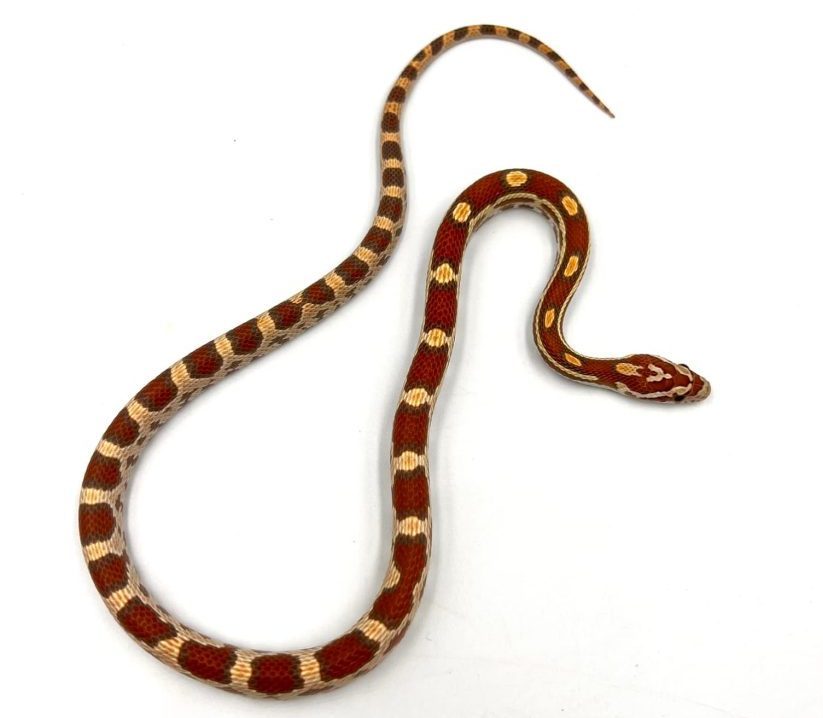
The mesmerizing beauty of this noble snake breed will make you stop & admire its brilliance. These crawling pals have a vibrant peach base with vivid red-orange blotches – you can notice these bordered by a bold white margin.
Additionally – these stunning reptile buddies have attractive, bloodred eyes!
As a naive pet parent – it can be difficult to distinguish between the standard & reverse Okeetee – as they both possess the same patterning. But remember colors of reverse Okeetee remain bright & distinct even when fully grown.
12. Snow (Amelanistic x Anerythristic)
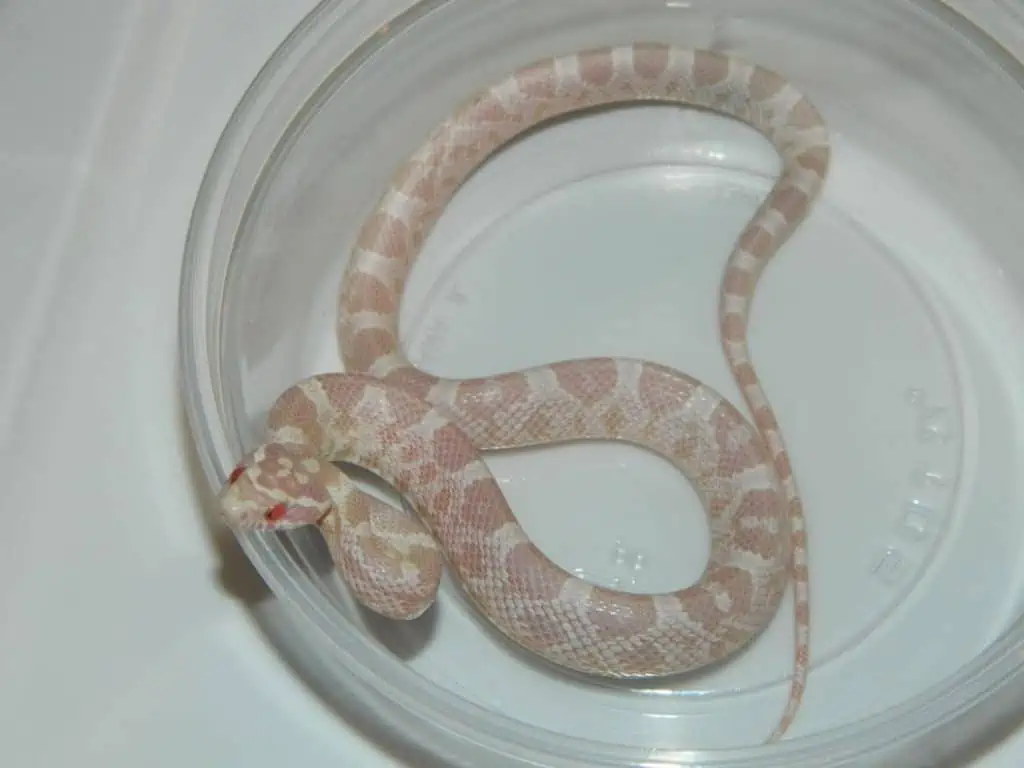
These 2 species determine the color of these pals:
- Amelanism deprives these slithery-friendly reptiles of black pigmentation.
- While anerythrism renders these buddies near-colorless, with light tan blotches as their primary hue.
13. Lavender
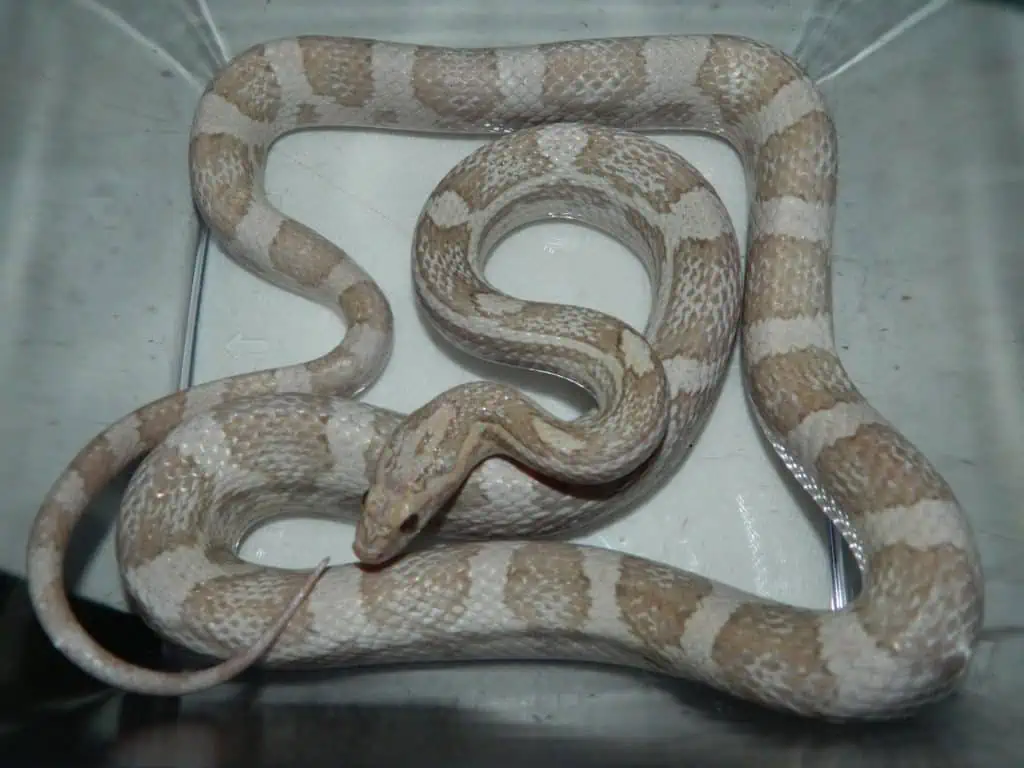
- All yellow pigments
- Most of the red & black pigments
This leaves these scaly reptiles with an enchanting purple/grey hue – their eyes are decorated in mesmerizing night sky patterns featuring ruby pupils, enthralling you as you take in their mesmerizing beauty.
The saddle & ground colors lack contrast, giving you the impression that these colorful reptiles have no or thin saddle borders.
14. Scaleless
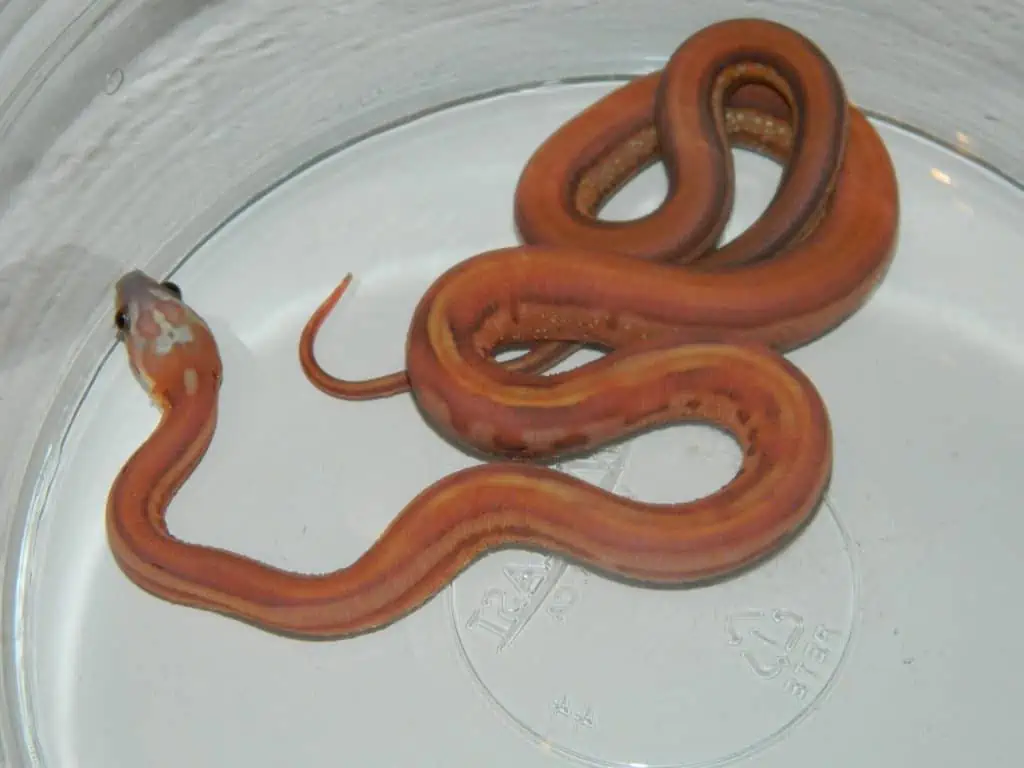
This staggering breed is created by crossbreeding the Great Plains Rat snake with a regular corn snake; although scaleless serpents lack scales on most of their body, these reptile friends have belly scutes – either all or just partially.
These scutes are necessary for them to be able to slither around. The natural colors of these reptiles are more prominent due to the absence of scales.
15. Palmetto
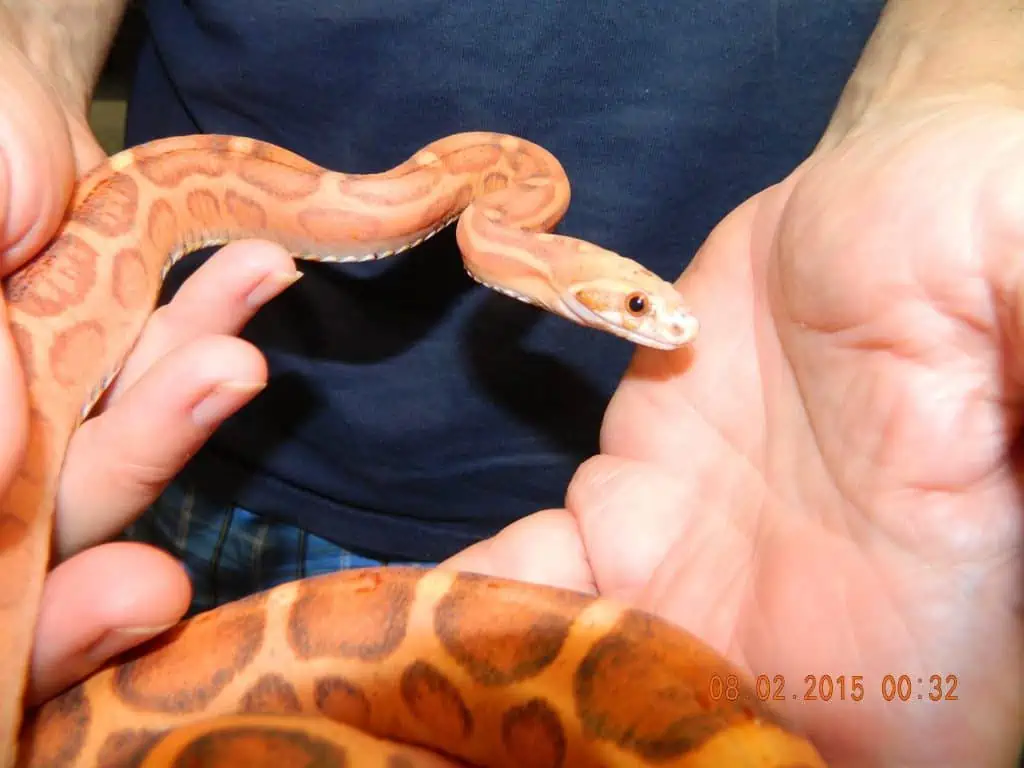
16. Tessera
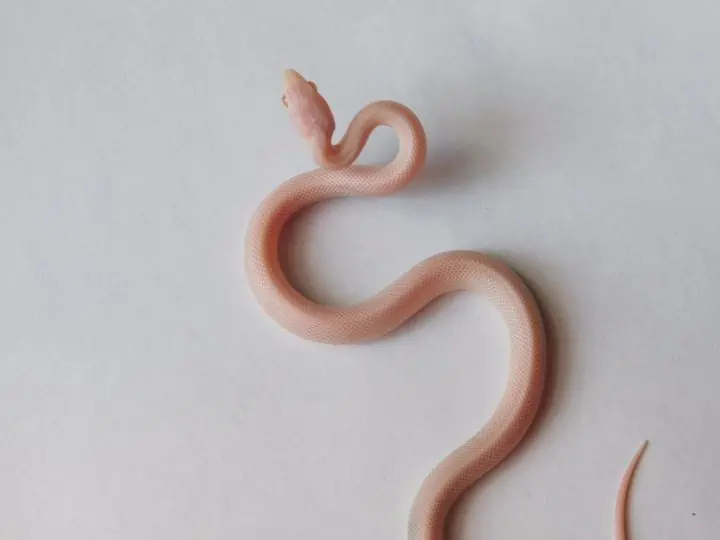
This mutation changes the snake’s body’s color and pattern–mostly earthy colors like beige, brown, brick red & black.
However – the eyes of Normal tesserae serpents look the same as those of Normal corn snakes.
17. Butter (Amelanistic x Caramel)
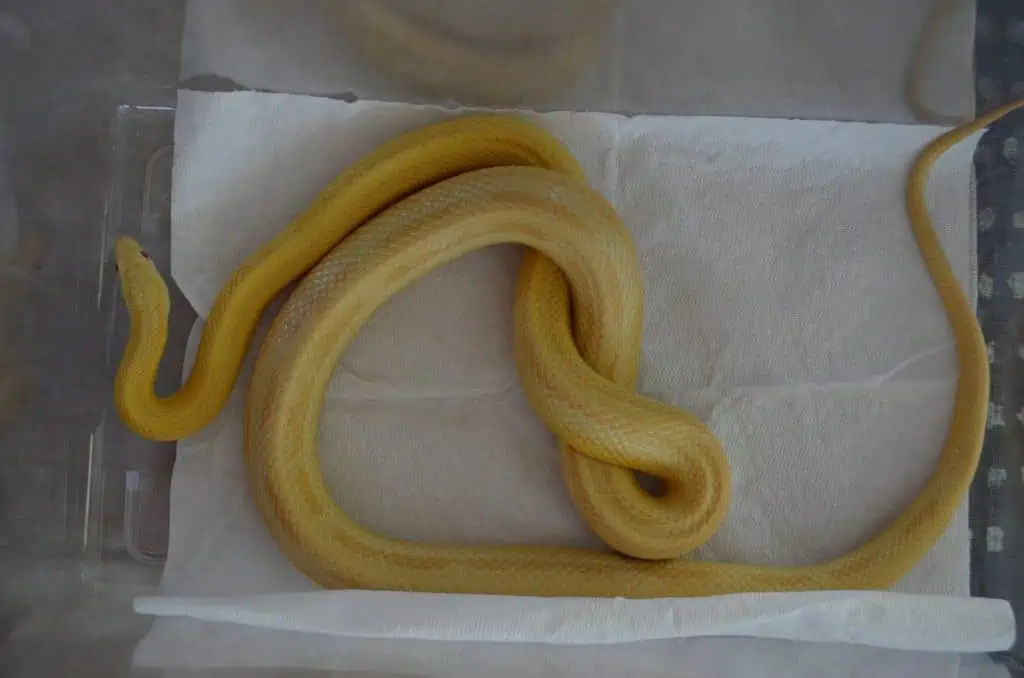
Typically – this amazing serpent’s skin backdrop is a light yellow, resembling butter, while the blotches are slightly darker.
18. Avalanche
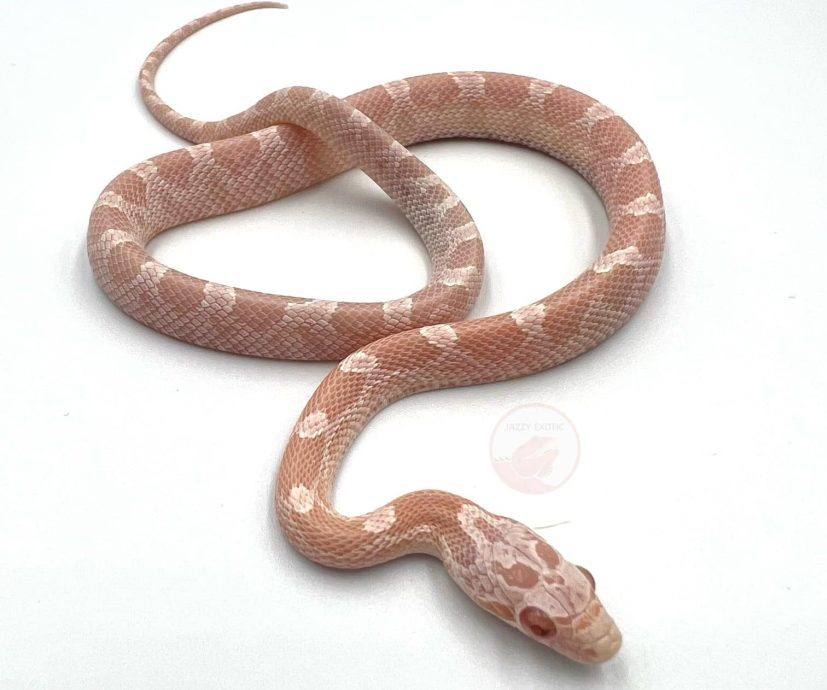
The noticeable features of the striking avalanche morph for you include:
- White bodies
- Pink undertones
- Red eyes
You can still observe a noticeable pattern despite being washed out and muted. This morph is also called diffused snow and bloodred snow and is considered very attractive.
19. Candy Cane
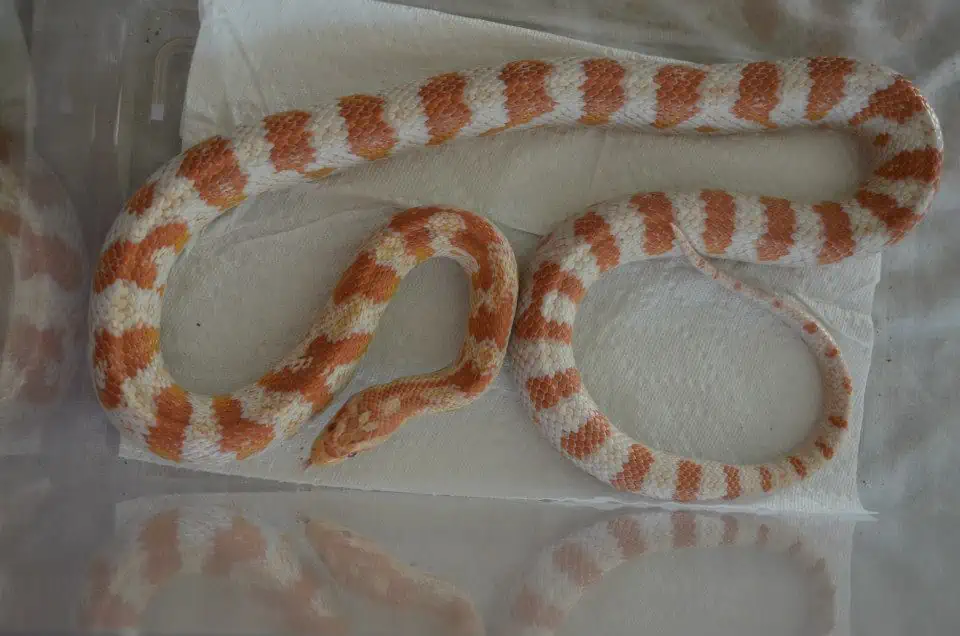
This pattern gives the snake its namesake – like a festive candy cane!
20. Pewter (Charcoal x Diffused)
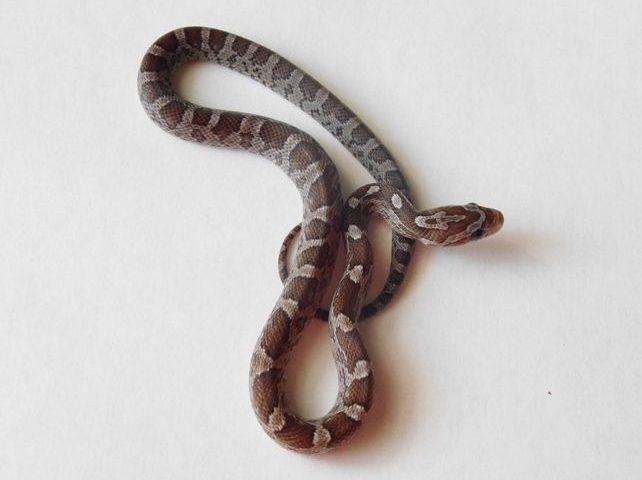
Through the diffused trait – this crawling buddy’s patterns minimize as the black & white shades merge into a gray tone. Their blotches are much more noticeable when they are newly hatched.
However – as they mature – the colors from the charcoal morph fade away – leaving behind a subdued pattern of gray shades.
21. Ghost (Anerythristic x Hypomelanistic)
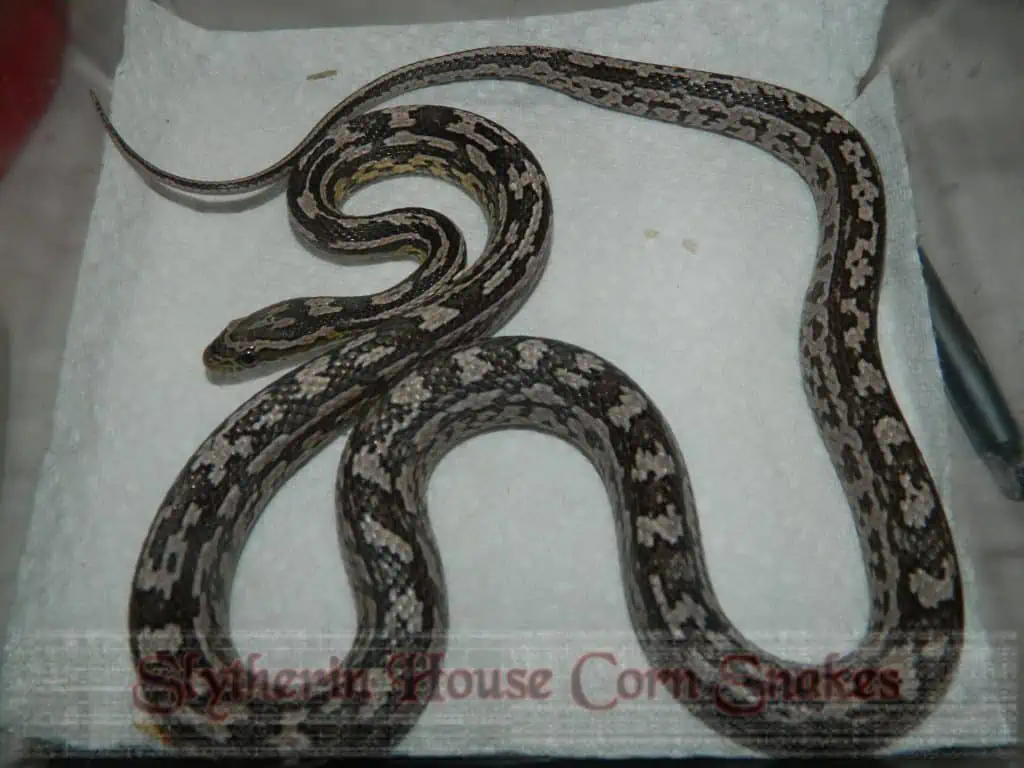
The Anerythristic trait removes red, orange & yellow colors — while the Hypomelanistic trait removes some black colors.
22. Opal (Amelanistic x Lavender)
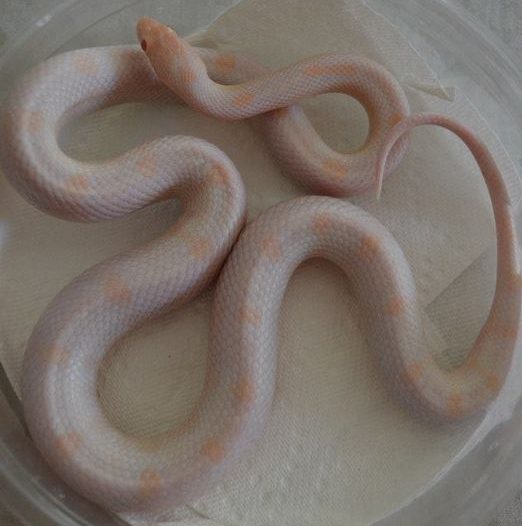
Opal morphs have both the lavender gene that takes out most of the orange & red pigments found in other morphs like the orange and mandarin ones and the amelanistic gene.
This combination results in white-based corn snakes that are either patternless or covered in pink blotches.
What Are the Best Morphs of Corn Snake?
According to pet snake owners – the best corn snakes have the most stunning colors and patterns, making them the most popular.
Here I’ve enlisted the five best corn snake morphs as determined by pet owners.
Striped Corn Snake
Corn serpents come in different colors – but they all have a noticeable stripe that runs down their back.
The best ones have clearer stripes on a dark background – such as cinder or charcoal stripe corns.
Topaz Motley Corn Snake
This awe-inspiring corn boasts beautiful yellow & amber hues on top – complemented by a white or cream color underneath.
As you can see, this scaly friend resembles the popular caramel corn snake – but features a distinct and captivating coloration.
Additionally – the reptile’s motley pattern removes the typical dark patches and replaces them with clear spots along its back.
Sunkissed Ultramel Corn Snake
Are you looking for a corn snake that closely resembles the natural (wild type) variety? 🧐 – then the Sunkissed Ultramel corn snake is the one for you.
While this astonishing reptilian buddy still displays the reds and oranges typical of a corn snake – the colors are more clearly defined and brighter & there is very little dark brown or black on the snake.
When fully grown – Ultramel corn snakes are a stunning sight to behold.
Buck Skin Okeetee
This striking corn snake morph has a great deal of variation in color & pattern. A distinctive feature of this corn snake is its black & white checkered underbelly. The underbelly, burnt orange, and light desert sand tan patterns make it a beautiful snake.
Blizzard (Amelanistic x Charcoal)
1984 the inaugural Blizzard was born by breeding a wild-caught anerythristic type B corn snake with a charcoal morph.
This brilliant breed of snakes is born with red eyes & completely white skin, which may develop faint lemon-lined margins around their blotches & yellow checkering on their belly as they mature.
To Sum It Up!
As we have seen – corn snakes come in various morphs and colors. While each of these breathtaking scaly buddies is unique and beautiful, some stand out.
The field of corn snake breeding has evolved, allowing enthusiasts to create more unique combinations of color and pattern variation than ever before.
By familiarizing yourself with different morph forms, you can find a corn snake perfect for your needs – whether in coloration or pattern.
Do you have a corn morph? – Which one from the list do you like best and why? Let us know in the comments below! 😇

